What development helped renaissance ideas travel north from italy
What development helped renaissance ideas travel north from italy
HOW DID THE IDEAS OF THE RENAISSANCE SPREAD?
The Renaissance is an important event in European history that stretched from the 14th century to the 17th century. It was preceded by the Middle Ages in Europe and eventually led to the major events of the Age of Enlightenment. In historical terms the Renaissance is important because it led to a major shift in European thought and worldview. This shift eventually led to the developments of the Enlightenment and set the stage for the modern western worldview. While the Renaissance is considered to have begun in the city-states of the Italian peninsula in the 14th century, the main ideas of the movement eventually spread to all of Europe by the 16th century. The most significant changes that emerged as a result of the Renaissance can be seen in European architecture, art, literature, mathematics, music, philosophy, politics, religion and science. Intellectual thought in these fields flourished during the timeframe of the Renaissance and led to many people questioning long held beliefs about each. This created an environment of discovery and curiosity in which new ideas were constantly being introduced and tested. Historians have been studying how, where and when the ideas of the Renaissance spread from its start in Italy to the rest of Europe.
WHY WAS THE RENAISSANCE SLOW TO SPREAD AT FIRST?
As stated above, the Renaissance first began on the Italian peninsula in the 14th century but later spread to the rest of Europe. The Renaissance first began in Italy due to a number of identified causes, such as: increased interaction between different cultures, the rediscovery of ancient Greek and Roman texts, the emergence of humanism, different artistic and technological innovations, and the impacts of conflict and death. However, initially the new ideas and perspectives of the Italian Renaissance were slow to spread out of Italy for several reasons, including: the rigidity of feudalism, conflicts and war, geography, and the influence of the Roman Catholic Church in Europe.


Feudalism was a form of government common during medieval Europe that involved society being structured in a very rigid and hierarchical way. It was popular in European society from the 9th century until the 15th century and was the form of government in which the country was dominated by an absolute monarch, in which all power was held within a single king. The monarch would rule over the country while the rest of the people were bound by a hierarchical system in which people were placed into classes in which they were born. For example, under feudalism, most people were peasants who worked tirelessly on farms of local lords. Feudalism was much more present in European society outside of Italy which caused the ideas of the Renaissance to spread slowly. This was because Feudal society was not as open to new ideas as the city-states that existed in Italy at the time. Powerful nobles and monarchs used the feudal system to keep out any new ideas that had the potential to threaten their wealth and authority in society.
The second reason that the Renaissance spread out of Italy slowly at first was the continuous conflicts and wars that occurred in the late Middle Ages and early Renaissance. For example, the Hundred Years’ War was a series of conflicts in Northern Europe between the kingdoms of France and England that occurred from 1337 to 1453. The war was fought over the control of territory in France and ultimately involved multiple kingdoms in western and northern Europe going to war. As a result, these regions were not as open to change and new ideas because they were preoccupied with constant conflict. As well, the Hundred Years’ war would have made travel between the different kingdoms in western Europe difficult and thus slowed the spread of scholars and artists who had the potential to spread the ideas of the Renaissance.
The third reason for the slow movement of Renaissance ideas out of Europe was the geography of northern Italy. Travel in the Late Middle Ages and early Renaissance time periods was difficult and treacherous but the isolated nature of the Italian peninsula made it particularly difficult for people and ideas to travel north to the rest of Europe. First, Italy is a peninsula meaning it is surrounded by the waters of the Mediterranean Sea on three sides. This obviously made travel over land impossible and limited the vast majority of people from reaching new areas.
Also, northern Italy contains the Alps which is the largest mountain range in all of Europe. This also limited ground travel as movement through the Alps at the time was a difficult task. As such, the natural geography of Italy limited the ability of Renaissance ideas to spread to the rest of Europe.

The final reason for the slow spread of the Renaissance from Italy to the other regions of Europe is the influence of the Roman Catholic Church. Catholicism and the authority of the Catholic Church played a major role in the lives of people throughout Europe. In fact, from 1309 to 1376 the Roman Catholic Church was located in Avignon, France instead of in Rome. This situation increased the influence of the church in mainland Europe. This is important because the Catholic Church was not necessarily open to the new ideas and changing worldview of the Renaissance in Italy and instead wanted to maintain the situation in Europe that had existed throughout the earlier Middle Ages. As a result, this caused many people in places such as western Europe to be less open to the ideals of the Renaissance.
WHY DID THE RENAISSANCE EVENTUALLY SPREAD OUT OF ITALY?
While the Renaissance was slow to spread at first, for the reasons mentioned above, it eventually did spread to the other regions of Europe. As such, historians have identified several reasons for why and how the Renaissance did reach the other kingdoms of the continent, including: a period of peace, innovations in art and publishing, and migrations of people.
First, the Renaissance ideas spread to Europe more quickly once several of the major conflicts had ended. For example, the Hundred Years’ War was a series of conflicts in Northern Europe between the kingdoms of France and England that occurred from 1337 to 1453. As stated previously, the war was fought over the control of territory in France and ultimately involved multiple kingdoms in western and northern Europe going to war. As a result, these regions were not as open to change and new ideas at the time because they were preoccupied with constant conflict. This slowed or prevented the spread of the Renaissance ideas in the earlier years of the Renaissance. However, when the Hundred Years’ War ended in the mid-15th century it allowed the ideas of the Italian Renaissance from the 14th century to extend north and west to other parts of Europe. As such, Europe experienced a relative period of peace in the 15th century after earlier centuries of war which allowed for more interaction, trade a travel which helped the new ideas to spread.
The second reason for why the spread of the Renaissance eventually sped up was due to innovations in publishing and art. In terms of publishing, the printing press was one of the most significant innovations in all of world history. German blacksmith, goldsmith and printer Johannes Gutenberg developed the first printing press in the mid-1400s and it quickly had a profound impact on the events of the Renaissance (as well as later events such as the Enlightenment). Prior to the printing press, books and other literature were created through a varied assortment of methods (woodblock press, etc.) which were all labor intensive and slow. Gutenberg’s invention was the development of a hand mold that allowed for precise movable type. This meant that he perfected the process of making movable type pieces for easily and quickly constructing type-font documents. This sped up the printing process and made it extremely affordable, which allowed for an explosion in the publishing and printing of books. For example, the Gutenberg Bible was the first book to be mass produced on the Gutenberg printing press. The invention and use of the printing press in Europe was important for the Renaissance because it allowed new ideas and worldviews to spread across the continent more easily. At its core, the Renaissance was about new ideas (such as humanism) overthrowing old views and customs (such as religious beliefs and practises and feudal traditions). Therefore, the invention of the printing press allowed these new ideas to spread and further enhance the overall Renaissance.
5 Key Ideas of the Renaissance
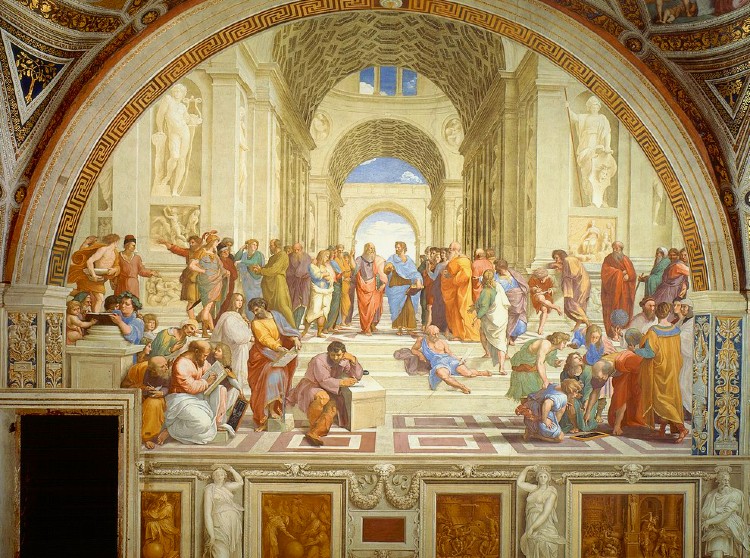

The Renaissance was one of Europe’s most significant historical periods, and is often characterised by the magnificent outpouring of art, literature, and scientific developments witnessed between the 15th and 17th centuries.
During this time new ideas spread across the continent, focused on the possibilities of mankind, the achievements of the individual, and the teachings of the ancient world – pushing Europe out of the ‘Dark Ages’ and towards a more enlightened and modern society.
Here are 5 key ideas fostered during the Renaissance:
Classicism
The Renaissance – meaning rebirth – found its roots in a growing reverence for the classical world that was emerging amongst scholars in the 15th century. Many believed that the societies of ancient Rome and Greece demonstrated qualities highly important to the success of civilisation, and that their emulation would reinvigorate Europe’s stunted progress during the ‘Dark Ages’.
A scramble for lost ancient texts thus began, with humanists methodically searching the monastic libraries of Europe, where many lay disregarded on dusty shelves.
It was not until the fall of Constantinople in 1453 that many of these texts resurfaced however, when Byzantine scholars were forced to flee to northern Italian cities like Florence, bringing them with them a host of new material. These texts laid the foundation of the Renaissance in Italy and indeed Europe as a whole, influencing everything from artwork to political tracts.
As such, the ancient world is reflected in many of the Renaissance’s most famous works – from Raphael’s School of Athens to Shakespeare‘s Coriolanus, ancient figures feature as characters to emulate or learn from.
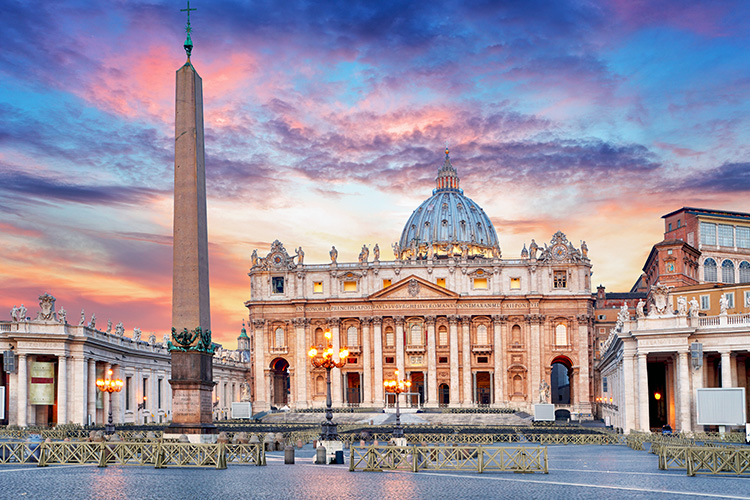
St. Peter’s Basilica in the Vatican City, constructed between 1506-1626 in the Renaissance style. Its columns, dome, and arches all evoke the architectural design of ancient Rome.
Image Credit: Shutterstock
Classicism also translated heavily into Renaissance architecture, with symmetry, proportion, and geometry viewed as beautiful and valuable attributes to have in the public sphere. The columns, domes, and niches of ancient Rome reappeared in Italy’s cities and soon spread throughout Europe, replacing the more complex and irregular designs of medieval buildings.
Humanism
Often intertwined with and informed by the classical world was the study of humanism. Humanism placed man at the centre of his own universe, and awarded great emphasis and interest in the study of humans and their activities throughout history. Thus, it threaded itself throughout many aspects of Renaissance life where humanists teachings could be widespread.
This became far easier in 1450 when the Gutenberg printing press was invented and a more rapid spread of information and ideas was now available. Texts by Italian humanists such as Petrarch and Boccaccio were printed and distributed, encouraging a return to ancient cultures and values, and it became easier than ever to be informed on new ways of thinking.
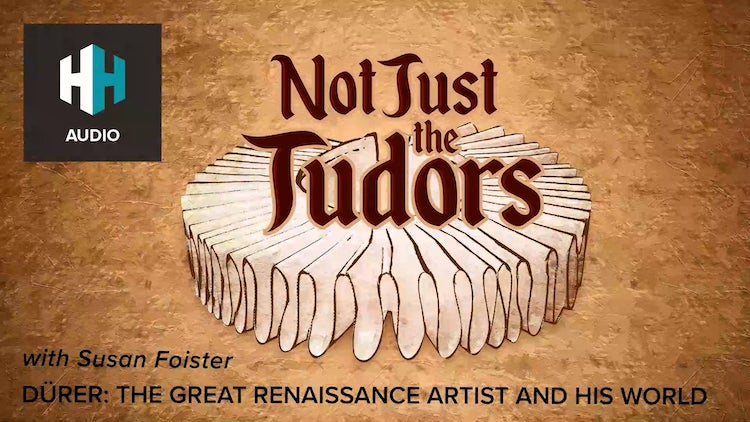
In spreading these ideas, humanists sought to create a society in which every citizen was able to speak, read, and write eloquently, contribute to their civic societies and encourage virtue in one another – as they believed the societies of the classical world had.
On the humanist agenda was also the sometimes-tricky subject of religion. Though most humanists were religious, many sought to ‘purify and renew Christianity’, seeking a return to the simplicity of the New Testament and a move away from the complicated doctrines of medieval worship.
Erasmus, often termed the ‘Prince of Humanism’, was influential in preparing new Greek and Latin versions of the New Testament in the 16th century that had wide-reaching implications for the future of Catholic worship, particularly with the Protestant Reformation looming on the horizon.
Individualism
One of the period’s most pertinent and long-lasting ideas was that the individual was capable of great things, and should aspire to be well-rounded and skilful in many disciplines.
This gave rise to the concept of the polymath or the ‘Renaissance man’, someone who was skilled in a variety of pursuits from art and sculpture to engineering and mathematics. Leonardo da Vinci for example, was both an extraordinary artist and a skilled inventor, while Michelangelo excelled in both sculpture and architecture.
With this new focus on individualism, artists in particular enjoyed a new-found sense of freedom and creativity. Often they had wealthy secular patrons who afforded them a degree of control over their work, and were as such not consigned to painting only religious or monarchical subjects. They painted self-portraits, signed their work, and strove to refine their skills, with artists like da Vinci conducting lengthy studies on the human form and its individual attributes.
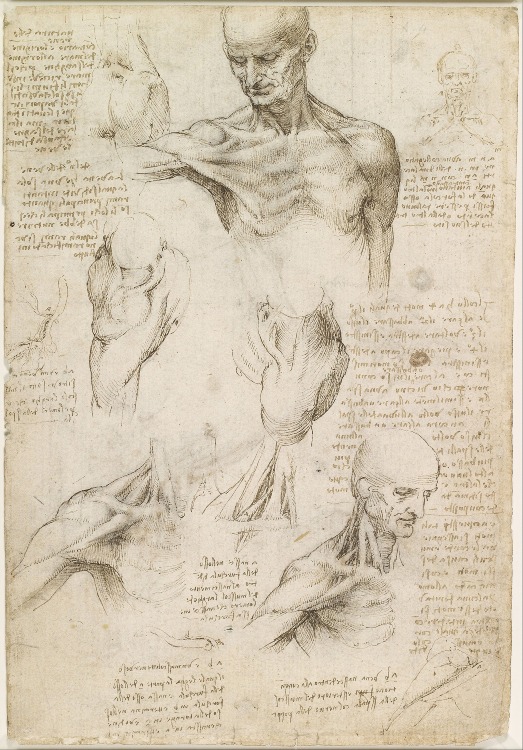
Superficial anatomy of the shoulder and neck by Leonardo da Vinci, c.1510.
Image Credit: Royal Collection / Public domain
With personal success also came personal wealth and the ability to choose one’s lifestyle. A rise in the merchant class and available markets meant a wider range of goods were available, with exploration bringing a vast array of new commodities to Europe such as sugar, coffee, and spices to delight the tastebuds. Individual tastes were allowed to blossom, accompanied by a growing appreciation of the secular world.
Secularism
Alongside Renaissance ideas of the individual came a rise in secularism and worldliness. More value was placed on life on earth and making it as special and comfortable as possible, rather than just passing it in sufferance on the journey to heaven. Many Renaissance figures believed cities and public spaces in particular should be beautiful to uplift their citizens and encourage them to behave in civilised and gracious manners.
Religious paintings became more lifelike and relatable, encouraging active rather than merely contemplative virtue in their audiences. Images of the Virgin Mary and Baby Jesus were no longer stiff and unapproachable, and goodness could and should be achieved by anyone, not just those inside the walls of the monastery.
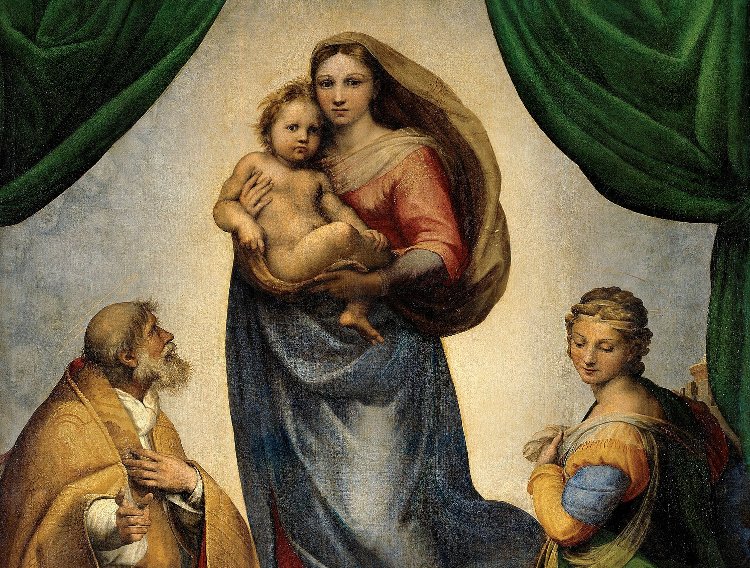
Sistine Madonna by Raphael, c.1513-14. Here the Virgin Mary and Baby Jesus reflect a relatable quality – they look like a real mother and infant child, rather than a pair of heavenly beings.
Image Credit: Public domain
This philosophical mission was largely instigated by powerful patrons of the arts such as the Medici family, who aspired to build their cities as glorious centres of truth, virtue, and progress as the ancient societies had done, and commissioned art that too encouraged these attributes.
Scepticism
Another key idea of the Renaissance was scepticism, with Renaissance thinkers encouraged to ask questions, ponder, consider, and experiment. Where previously an unwavering faith in God’s plan was encouraged by the medieval Church, the Renaissance promoted the idea that the world was full of mysteries waiting to be discovered through human achievement.
Developments in science rapidly followed after a period of stagnation during the Middle Ages, with new and world-altering discoveries in astronomy, mathematics, anatomy, geography, and engineering exploding during the period. Mathematician Luca Pacioli developed the basis of modern-day accounting, while Andreas Vesalius reached important conclusions regarding the human skeleton.
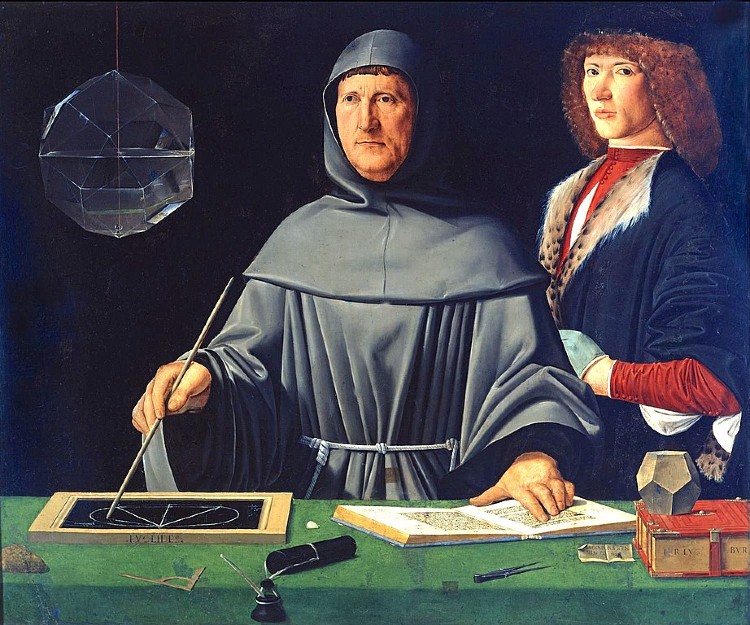
Portrait of Luca Pacioli by Leonardo da Vinci, 1495. Pacioli was an Italian mathematician and early contributor to the field of accounting.
Image Credit: Public domain
Astronomy in particular made huge leaps during the Renaissance. Copernicus first hypothesised that the Earth moved around the sun, not the other way around as had been previously assumed, while Galileo invented the first telescope revealing that the moon was in fact cratered and did not give off its own light, but instead reflected it.
Alongside the telescope came eyeglasses and microscopes, while the first mechanical clocks and cannons signalled a move away from the feudal medieval world of ‘church time’ and knights in armour.
Scepticism and the rise in new scientific discoveries was not welcomed by all however. When Galileo publicly agreed with Copernicus’ hypothesis on the earth’s movement, he was put under house arrest by the Catholic Church!
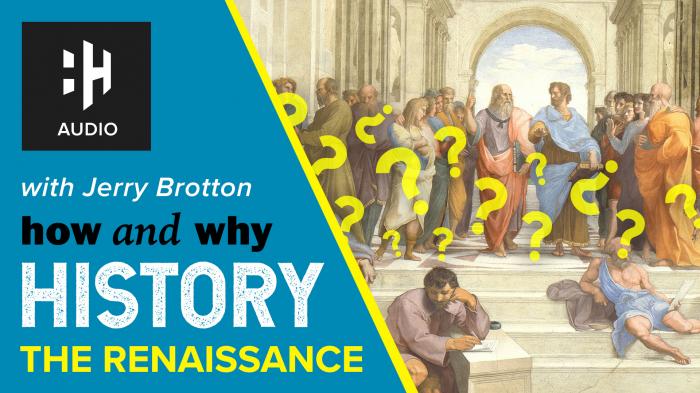
Spreading throughout the length and breadth of Europe, the Renaissance made an enduring impact on art and architecture, science, politics and law. Rob Weinberg puts the big questions about this world-changing period to Professor Jerry Brotton of Queen Mary University of London.
Similarly, when Martin Luther’s denial of the Catholic Church’s authority and virtue became influential in the Protestant movement, they launched a brutal and bloody Counter-Reformation in attempts to stamp out what they considered heresy. Even Erasmus who had remained a moderate Catholic all his life risked being accused of heresy for his questioning of the Church, and soon many forms of Renaissance thinking became akin with religious dissent.
With a whole new sphere of ideas rippling throughout Europe, the stage was set for brand new social and religious challenges. Blind subservience to the Catholic Church was no more, new realms of the globe had begun to be colonised, new technologies had been harnessed on an increasingly wide scale. The making of the modern world had begun.
Renaissance
The Renaissance was a fervent period of European cultural, artistic, political and economic “rebirth” following the Middle Ages. Generally described as taking place from the 14th century to the 17th century, the Renaissance promoted the rediscovery of classical philosophy, literature and art. Some of the greatest thinkers, authors, statesmen, scientists and artists in human history thrived during this era, while global exploration opened up new lands and cultures to European commerce. The Renaissance is credited with bridging the gap between the Middle Ages and modern-day civilization.

Experience the Medici in Florence with HISTORY Travel™. Click to learn more!
From Darkness to Light: The Renaissance Begins
During the Middle Ages, a period that took place between the fall of ancient Rome in 476 A.D. and the beginning of the 14th century, Europeans made few advances in science and art.
Also known as the “Dark Ages,” the era is often branded as a time of war, ignorance, famine and pandemics such as the Black Death.
Some historians, however, believe that such grim depictions of the Middle Ages were greatly exaggerated, though many agree that there was relatively little regard for ancient Greek and Roman philosophies and learning at the time.
Humanism
During the 14th century, a cultural movement called humanism began to gain momentum in Italy. Among its many principles, humanism promoted the idea that man was the center of his own universe, and people should embrace human achievements in education, classical arts, literature and science.
In 1450, the invention of the Gutenberg printing press allowed for improved communication throughout Europe and for ideas to spread more quickly.
As a result of this advance in communication, little-known texts from early humanist authors such as those by Francesco Petrarch and Giovanni Boccaccio, which promoted the renewal of traditional Greek and Roman culture and values, were printed and distributed to the masses.
Additionally, many scholars believe advances in international finance and trade impacted culture in Europe and set the stage for the Renaissance.
Medici Family
The Renaissance started in Florence, Italy, a place with a rich cultural history where wealthy citizens could afford to support budding artists.
Members of the powerful Medici family, which ruled Florence for more than 60 years, were famous backers of the movement.
Great Italian writers, artists, politicians and others declared that they were participating in an intellectual and artistic revolution that would be much different from what they experienced during the Dark Ages.
The movement first expanded to other Italian city-states, such as Venice, Milan, Bologna, Ferrara and Rome. Then, during the 15th century, Renaissance ideas spread from Italy to France and then throughout western and northern Europe.
Although other European countries experienced their Renaissance later than Italy, the impacts were still revolutionary.
Renaissance Geniuses
Some of the most famous and groundbreaking Renaissance intellectuals, artists, scientists and writers include the likes of:
Leonardo da Vinci (1452–1519): Italian painter, architect, inventor and “Renaissance man” responsible for painting “The Mona Lisa” and “The Last Supper.
Desiderius Erasmus (1466–1536): Scholar from Holland who defined the humanist movement in Northern Europe. Translator of the New Testament into Greek.
Rene Descartes (1596–1650): French philosopher and mathematician regarded as the father of modern philosophy. Famous for stating, “I think; therefore I am.”
Galileo (1564-1642): Italian astronomer, physicist and engineer whose pioneering work with telescopes enabled him to describes the moons of Jupiter and rings of Saturn. Placed under house arrest for his views of a heliocentric universe.
Nicolaus Copernicus (1473–1543): Mathematician and astronomer who made first modern scientific argument for the concept of a heliocentric solar system.
Thomas Hobbes (1588–1679): English philosopher and author of “Leviathan.”
Geoffrey Chaucer (1343–1400): English poet and author of “The Canterbury Tales.”
Giotto (1266-1337): Italian painter and architect whose more realistic depictions of human emotions influenced generations of artists. Best known for his frescoes in the Scrovegni Chapel in Padua.
Dante (1265–1321): Italian philosopher, poet, writer and political thinker who authored “The Divine Comedy.”
Niccolo Machiavelli (1469–1527): Italian diplomat and philosopher famous for writing “The Prince” and “The Discourses on Livy.”
Titian (1488–1576): Italian painter celebrated for his portraits of Pope Paul III and Charles I and his later religious and mythical paintings like “Venus and Adonis” and “Metamorphoses.”
William Tyndale (1494–1536): English biblical translator, humanist and scholar burned at the stake for translating the Bible into English.
William Byrd (1539/40–1623): English composer known for his development of the English madrigal and his religious organ music.
John Milton (1608–1674): English poet and historian who wrote the epic poem “Paradise Lost.”
William Shakespeare (1564–1616): England’s “national poet” and the most famous playwright of all time, celebrated for his sonnets and plays like “Romeo and Juliet.”
Donatello (1386–1466): Italian sculptor celebrated for lifelike sculptures like “David,” commissioned by the Medici family.
Sandro Botticelli (1445–1510): Italian painter of “Birth of Venus.”
Raphael (1483–1520): Italian painter who learned from da Vinci and Michelangelo. Best known for his paintings of the Madonna and “The School of Athens.”
Michelangelo (1475–1564): Italian sculptor, painter and architect who carved “David” and painted The Sistine Chapel in Rome.
Renaissance Art, Architecture and Science
Art, architecture and science were closely linked during the Renaissance. In fact, it was a unique time when these fields of study fused together seamlessly.
For instance, artists like da Vinci incorporated scientific principles, such as anatomy into their work, so they could recreate the human body with extraordinary precision.
Architects such as Filippo Brunelleschi studied mathematics to accurately engineer and design immense buildings with expansive domes.
Scientific discoveries led to major shifts in thinking: Galileo and Descartes presented a new view of astronomy and mathematics, while Copernicus proposed that the Sun, not the Earth, was the center of the solar system.
Recommended for you
Louisiana
Paris Commune of 1871
Why the War of 1812 Was a Turning Point for Native Americans
Renaissance art was characterized by realism and naturalism. Artists strived to depict people and objects in a true-to-life way.
They used techniques, such as perspective, shadows and light to add depth to their work. Emotion was another quality that artists tried to infuse into their pieces.
Some of the most famous artistic works that were produced during the Renaissance include:
- The Mona Lisa (Da Vinci)
- The Last Supper (Da Vinci)
- Statue of David (Michelangelo)
- The Birth of Venus (Botticelli)
- The Creation of Adam (Michelangelo)
Renaissance Exploration
While many artists and thinkers used their talents to express new ideas, some Europeans took to the seas to learn more about the world around them. In a period known as the Age of Discovery, several important explorations were made.
Voyagers launched expeditions to travel the entire globe. They discovered new shipping routes to the Americas, India and the Far East and explorers trekked across areas that weren’t fully mapped.
Renaissance Religion
Humanism encouraged Europeans to question the role of the Roman Catholic church during the Renaissance.
As more people learned how to read, write and interpret ideas, they began to closely examine and critique religion as they knew it. Also, the printing press allowed for texts, including the Bible, to be easily reproduced and widely read by the people, themselves, for the first time.
In the 16th century, Martin Luther, a German monk, led the Protestant Reformation – a revolutionary movement that caused a split in the Catholic church. Luther questioned many of the practices of the church and whether they aligned with the teachings of the Bible.
As a result, a new form of Christianity, known as Protestantism, was created.
End of the Renaissance
Scholars believe the demise of the Renaissance was the result of several compounding factors.
By the end of the 15th century, numerous wars had plagued the Italian peninsula. Spanish, French and German invaders battling for Italian territories caused disruption and instability in the region.
Also, changing trade routes led to a period of economic decline and limited the amount of money that wealthy contributors could spend on the arts.
Later, in a movement known as the Counter-Reformation, the Catholic church censored artists and writers in response to the Protestant Reformation. Many Renaissance thinkers feared being too bold, which stifled creativity.
Furthermore, in 1545, the Council of Trent established the Roman Inquisition, which made humanism and any views that challenged the Catholic church an act of heresy punishable by death.
By the early 17th century, the Renaissance movement had died out, giving way to the Age of Enlightenment.
Debate Over the Renaissance
While many scholars view the Renaissance as a unique and exciting time in European history, others argue that the period wasn’t much different from the Middle Ages and that both eras overlapped more than traditional accounts suggest.
Also, some modern historians believe that the Middle Ages had a cultural identity that’s been downplayed throughout history and overshadowed by the Renaissance era.
While the exact timing and overall impact of the Renaissance is sometimes debated, there’s little dispute that the events of the period ultimately led to advances that changed the way people understood and interpreted the world around them.
Sources
The Renaissance, History World International.
The Renaissance – Why it Changed the World, The Telegraph.
Facts About the Renaissance, Biography Online.
Facts About the Renaissance Period, Interestingfacts.org.
What is Humanism? International Humanist and Ethical Union.
Why Did the Italian Renaissance End? Dailyhistory.org.
The Myth of the Renaissance in Europe, BBC.
Source https://www.historycrunch.com/how-did-the-ideas-of-the-renaissance-spread.html
Source https://www.historyhit.com/key-ideas-of-the-renaissance/
Source https://www.history.com/topics/renaissance/renaissance